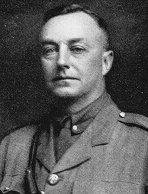
Major Charles Herbert McLean was born in Gagetown, New Brunswick on 16th May 1877. In his civilian life Charles worked as a barrister (a lawyer) in the city of Saint John, New Brunswick.
Prior to the Great War Charles served with the 28 New Brunswick Dragoons in Saint John where he obtained the rank of Major. At the outbreak of the Great War, Charles immediately volunteered and was selected to head a Squadron of cavalrymen. Commanding 'B' Squadron of the 6th Canadian Mounted Rifles (6CMR), which were the Maritime Regiment of the CMRs, with 'A' Squadron recruiting in Moncton, New Brunswick, and 'C' Squadron in Amherst, Nova Scotia.
Charles applied strict recruitment standards and only men of great physical and mental health were selected to join 'B' Squadron. Additionally, he required that each man must be an expert horseman and not have been previously rejected for service from any other branch or unit of the Canadian Expeditionary Force (CEF).
Training his Squadron in Saint John, they utilized the Exhibition Grounds horse tracks for mounted drills. The men of 'B' Squadron trained hard as their ranks continued to grow.
In early 1915 the 6CMR received orders to move to Amherst to join the other Squadrons and to continue training there. After training for three months in Amherst, the 6CMR moved to Valcartier, Quebec, where they were brigaded with the 4CMR and 5CMR. After continued training in Valcartier, Charles led the men of 'B' Squadron onto the SS Herschel, on which they departed for Plymouth, United Kingdom, on 18 July 1915.
The 6CMR arrived in Plymouth on 28th July 1915 with 32 officers and 598 enlisted men. Charles and the men continued training once in the United Kingdom and were garrisoned near Folkestone. On 24th October 'B' Squadron and the rest of the 6CMR departed Folkestone Harbour and landed in Boulogne-Sur-Mer, France. In November he led the men of 'B' Squadron into the trenches on their first training tours to the front.
Major McLean and 'B' Squadron were transferred to the 4CMR under divisional restructuring in the New Year, forming 'D' Company of the 4CMR. Charles became the OC of 'D' Company.
On 9th January 1916 Charles was on horseback whilst the regoiment was in Corps Reserve, when, inthe dark, a car collided with his mount. The horse fell, crushing Charles' left leg and causing a minor fracture to his ankle. Transferred to hospital for treatment, he quickly recovered and on 11th April 1916 he rejoined 'D' Company.
Just before the fateful morning of 2nd June 1916, Charles and 'D' Company took up front line positions in trenched 47 to 51, near Sanctuary Wood, in the infamous Ypres Salient sector. When the 'Battle for Mount Sorrel' opened that morning, Charles is reported to have been at the front and in the thick of the fighting during the German attack. 195 men were killed, 350 taken prisoner, and over 70 wounded, in the extended barrage on the 4CMR positions. Despite this, Charles both survived the battle and evaded capture by the Germans to be one of the very few to come out alive that day.
In September of 1916 the 4CMR was transferred from the Ypres sector to the Somme battlefield, Charles included. Just before the attack on Courcelette, on 13th September, Charles was buried by a shell explosion and again injured, his right leg this time being strained. He was evacuated and thus did not participate in the 'Battle of Flers-Courcelette'. On 20th September 1916 Chalres was taken off strength from the Battalion and transferred to a hospital in the UK.
After recovering from his injuries Charles was transferred to the Canadian Reserve Cavalry Brigade in December of 1916, where he took a position training new cavalrymen. He remained in a training role, fully recovering from his injuries, until 4th July 1918.
On 2nd September 1918 (after two years being away from the front( Charles rejoined the 4CMR, arriving back with his old unit in the midst of the Last 100 Days Offensives.
in Early November of 1918, just days before the end of the Great War, the 4CMR were making daring patrols across a canal. During one such patrol, Charles performed actions which would see him awarded the Distinguished Service Order 'DSO'. The citation for his DSO reads as follows:
"For conspicuous gallantry and devotion to duty near Valenciennes on 1st November, 1918. With a view to locating points for bridging the Escaut Canal, he and one man crossed it on an improvised bridge of a plank, raft and boat. Here he was immediately engaged by a machine gun, which he at once attacked, killing one man, and holding the remainder at bay until assistance arrived, when he captured the machine gun and ten men. A post was thus established, which enabled a crossing to be effected on the entire battalion frontage without a casualty."
Charles survived the Great War, celebrating victory with the Battalion ten days later on 11th November 1918.
On 26th February 1919 Major Charles Herbert McLean received his DSO from His Majesty the King at Buckingham Palace. In addition to his DSO, Charles was also mentioned in Despatches. After being awarded the DSO by the King, Charles would at long last begin his journey home.
He arrived back on the Port City of Saint John, New Brunswick, on 28th March, with four other men, the survivors of the original 'B' Squadron 6CMR. Charles returned to civilian life in Saint John, and would pass away in peace, in Montreal, in November 1940, aged 62.
Biography credit with thanks to Alex Clayton.
Image supplied by courtesy of the John Clarke collection.